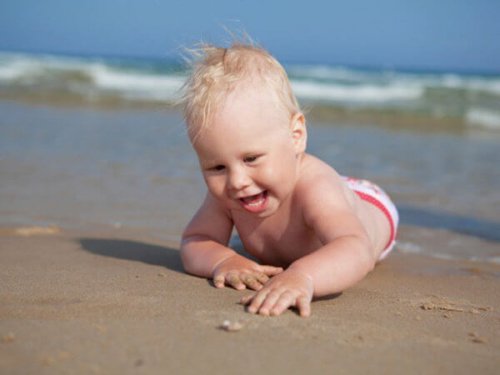What Is The Galant Reflex And How Is It Triggered?

When our baby is growing, they may experience different types of reflexes in their body, more than we really know. The Galant reflex, which is also known as truncal incurvation reflex, is one of them, and usually disappears when the baby is around one year old.
This reflex is a muscular reaction and happens automatically in response to stimulation.
How is the Galant reflex triggered?
In order to produce the Galant reflex, we must stimulate our baby. To do this, we must place the child face down on top of our hand and stroke both sides of the spine (from the shoulder to the buttocks), with our fingers, first on one side and then on the other.
Immediately, the baby should respond to the stimulus by curving the spine towards the stimulated side. As we mentioned earlier, this reflex should disappear before the baby reaches one year of age.
The main function of the Galant reflex is to develop the yet-to-be-born baby’s vestibular sense and to help the child pass through the birth canal.
However, if the reflex remains after the first year, any friction in the lower back will cause the child to turn his or her hip in that direction.
On top of that, it can cause problems in potty training and prevent the child from being able to sit still in a chair for long periods of time.

Signs that indicate the reflex isn’t present
If the reflex isn’t present, the child may experience hypersensitivity in their back. This means they won’t be able to put up with very tight clothes.
In general, everything at waist level will annoy him, and he’ll generally prefer looser clothes.
This discomfort can even cause problems of concentration or attention in any activity they have to do while sitting down. It may also affect their short-term memory.
A child who doesn’t experience this reflex can experience many problems. Among them are problems with eye to hand coordination, clumsiness in the lower body, and back problems when they’re older.
There is even a link between children lacking this reflex from birth and them wetting the bed up to and over 5 years of age.
Other secondary reflexes in a baby
1. The Moro Reflex: The first thing you should do is place the child on a soft surface, hold them and gently pull their wrists, separating them a little and letting them fall backwards. The baby will react by opening his arms and throwing them forward, as if he wants to give a hug. After this, he usually starts crying. Normally, this reflex lasts until a child is four months old.
2. Parachute Reflex: To be able to perceive this reflex, the baby should be held upside down by their sides and then tilted forward. With this stimulus he will react by opening his arms and hands. Normally, this reflex appears at around six months and disappears when it reaches nine months.
3. Step Reflex: In this one we hold the baby around their stomach area, holding them at the same time by their armpits. We then try to make them stand up. At this point the baby will begin to make movements as if it were taking its first steps. If we put the child on a solid surface, it will try to move forward little by little. This is how the process of learning to walk begins.

But these aren’t the only ones…
1. Landau reflex: If we place the baby face down in the ventral position, his upper body will straighten, his head will rise and his feet and arms will stretch instinctively. It’s normal for this reflex to appear around the fourth month and disappear towards the tenth month of the baby’s life.
2. Drag Reflex: For the baby to react to this reflex, we must place him upside down. He’ll then try to move his legs to start crawling. You can help him by placing your thumbs under their feet and they will support him. The normal thing is for this reflex to be present until they are 3 months old.
3. Rooting Reflex: When we stroke or touch the baby’s lips, he turns his head and opens his mouth to find where this contact has come from. Developing this reflex helps the child learn to look for his mother’s breast or the bottle. From the first month they can produce this reflex.
4. Crawling Reflex: We need to put the baby face down on his tummy, on a safe solid base. He’ll immediately react and move himself into a crawling position. This reflex appears at around 6 or 7 months and it’s maintained until they start to walk.
Babies experience many types of reflexes from birth until their first birthday. We must pay careful attention to every one, and ensure that they experience each one in its corresponding period.
If you notice that any of them occurs outside this normal time span, then consult your pediatrician in order to get a proper diagnosis.